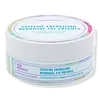What's inside
What's inside
 Key Ingredients
Key Ingredients

 Benefits
Benefits

 Concerns
Concerns

No concerns
 Ingredients Side-by-side
Ingredients Side-by-side

Water
Skin ConditioningPolyacrylic Acid
Emulsion StabilisingGlycerin
HumectantOlea Europaea Fruit Oil
MaskingAngelica Archangelica Root Water
Skin ConditioningSodium Hydroxide
BufferingGinkgo Biloba Leaf Extract
Skin ConditioningAcetyl Hexapeptide-8
HumectantHydrolyzed Extensin
Skin ConditioningAgar
MaskingCaprylyl Glycol
EmollientPerfluorodecalin
Skin ConditioningSimmondsia Chinensis Seed Oil
EmollientXanthan Gum
EmulsifyingUbiquinone
AntioxidantThymus Vulgaris Flower/Leaf Extract
MaskingBuddleja Davidii Extract
Skin ConditioningRubus Chamaemorus Seed Oil
Skin ConditioningOxycoccus Palustris Seed Oil
AntioxidantAluminum Glycinate
AstringentPolysorbate 60
EmulsifyingCeramide NP
Skin Conditioning1,2-Hexanediol
Skin ConditioningSucrose Palmitate
EmollientPotassium Sorbate
PreservativeSodium Benzoate
MaskingWater, Polyacrylic Acid, Glycerin, Olea Europaea Fruit Oil, Angelica Archangelica Root Water, Sodium Hydroxide, Ginkgo Biloba Leaf Extract, Acetyl Hexapeptide-8, Hydrolyzed Extensin, Agar, Caprylyl Glycol, Perfluorodecalin, Simmondsia Chinensis Seed Oil, Xanthan Gum, Ubiquinone, Thymus Vulgaris Flower/Leaf Extract, Buddleja Davidii Extract, Rubus Chamaemorus Seed Oil, Oxycoccus Palustris Seed Oil, Aluminum Glycinate, Polysorbate 60, Ceramide NP, 1,2-Hexanediol, Sucrose Palmitate, Potassium Sorbate, Sodium Benzoate
Water
Skin ConditioningGlycerin
HumectantNiacinamide
SmoothingCarrageenan
Caffeine
Skin ConditioningAcetyl Tetrapeptide-5
HumectantCeratonia Siliqua Gum
EmollientCyamopsis Tetragonoloba Gum
Emulsion StabilisingCellulose Gum
Emulsion StabilisingRicinus Communis Seed Oil
MaskingGlucomannan
Skin ConditioningAllantoin
Skin ConditioningSodium Hyaluronate
HumectantAstragalus Membranaceus Root Extract
EmollientGlycyrrhiza Uralensis Root Extract
Skin ConditioningCamellia Sinensis Leaf Extract
AntimicrobialAloe Barbadensis Leaf Juice
Skin ConditioningButylene Glycol
HumectantCalcium Lactate
AstringentSucrose
HumectantCalcium Chloride
AstringentPotassium Chloride
Arginine
MaskingPhenoxyethanol
PreservativeSodium Benzoate
Masking1,2-Hexanediol
Skin ConditioningCaprylyl Glycol
EmollientPolyglyceryl-4 Caprate
EmulsifyingWater, Glycerin, Niacinamide, Carrageenan, Caffeine, Acetyl Tetrapeptide-5, Ceratonia Siliqua Gum, Cyamopsis Tetragonoloba Gum, Cellulose Gum, Ricinus Communis Seed Oil, Glucomannan, Allantoin, Sodium Hyaluronate, Astragalus Membranaceus Root Extract, Glycyrrhiza Uralensis Root Extract, Camellia Sinensis Leaf Extract, Aloe Barbadensis Leaf Juice, Butylene Glycol, Calcium Lactate, Sucrose, Calcium Chloride, Potassium Chloride, Arginine, Phenoxyethanol, Sodium Benzoate, 1,2-Hexanediol, Caprylyl Glycol, Polyglyceryl-4 Caprate
 Reviews
Reviews

Ingredients Explained
These ingredients are found in both products.
Ingredients higher up in an ingredient list are typically present in a larger amount.
1,2-Hexanediol is a synthetic liquid and another multi-functional powerhouse.
It is a:
- Humectant, drawing moisture into the skin
- Emollient, helping to soften skin
- Solvent, dispersing and stabilizing formulas
- Preservative booster, enhancing the antimicrobial activity of other preservatives
Caprylyl Glycol is a humectant and emollient, meaning it attracts and preserves moisture.
It is a common ingredient in many products, especially those designed to hydrate skin. The primary benefits are retaining moisture, skin softening, and promoting a healthy skin barrier.
Though Caprylyl Glycol is an alcohol derived from fatty acids, it is not the kind that can dry out skin.
This ingredient is also used as a preservative to extend the life of products. It has slight antimicrobial properties.
Learn more about Caprylyl GlycolGlycerin is already naturally found in your skin. It helps moisturize and protect your skin.
A study from 2016 found glycerin to be more effective as a humectant than AHAs and hyaluronic acid.
As a humectant, it helps the skin stay hydrated by pulling moisture to your skin. The low molecular weight of glycerin allows it to pull moisture into the deeper layers of your skin.
Hydrated skin improves your skin barrier; Your skin barrier helps protect against irritants and bacteria.
Glycerin has also been found to have antimicrobial and antiviral properties. Due to these properties, glycerin is often used in wound and burn treatments.
In cosmetics, glycerin is usually derived from plants such as soybean or palm. However, it can also be sourced from animals, such as tallow or animal fat.
This ingredient is organic, colorless, odorless, and non-toxic.
Glycerin is the name for this ingredient in American English. British English uses Glycerol/Glycerine.
Learn more about GlycerinSodium Benzoate is a preservative. It's used in both cosmetic and food products to inhibit the growth of mold and bacteria. It is typically produced synthetically.
Both the US FDA and EU Health Committee have approved the use of sodium benzoate. In the US, levels of 0.1% (of the total product) are allowed.
Sodium benzoate works as a preservative by inhibiting the growth of bacteria inside of cells. It prevents the cell from fermenting a type of sugar using an enzyme called phosphofructokinase.
It is the salt of benzoic acid. Foods containing sodium benzoate include soda, salad dressings, condiments, fruit juices, wines, and snack foods.
Studies for using ascorbic acid and sodium benzoate in cosmetics are lacking, especially in skincare routines with multiple steps.
We always recommend speaking with a professional, such as a dermatologist, if you have any concerns.
Learn more about Sodium BenzoateWater. It's the most common cosmetic ingredient of all. You'll usually see it at the top of ingredient lists, meaning that it makes up the largest part of the product.
So why is it so popular? Water most often acts as a solvent - this means that it helps dissolve other ingredients into the formulation.
You'll also recognize water as that liquid we all need to stay alive. If you see this, drink a glass of water. Stay hydrated!
Learn more about Water